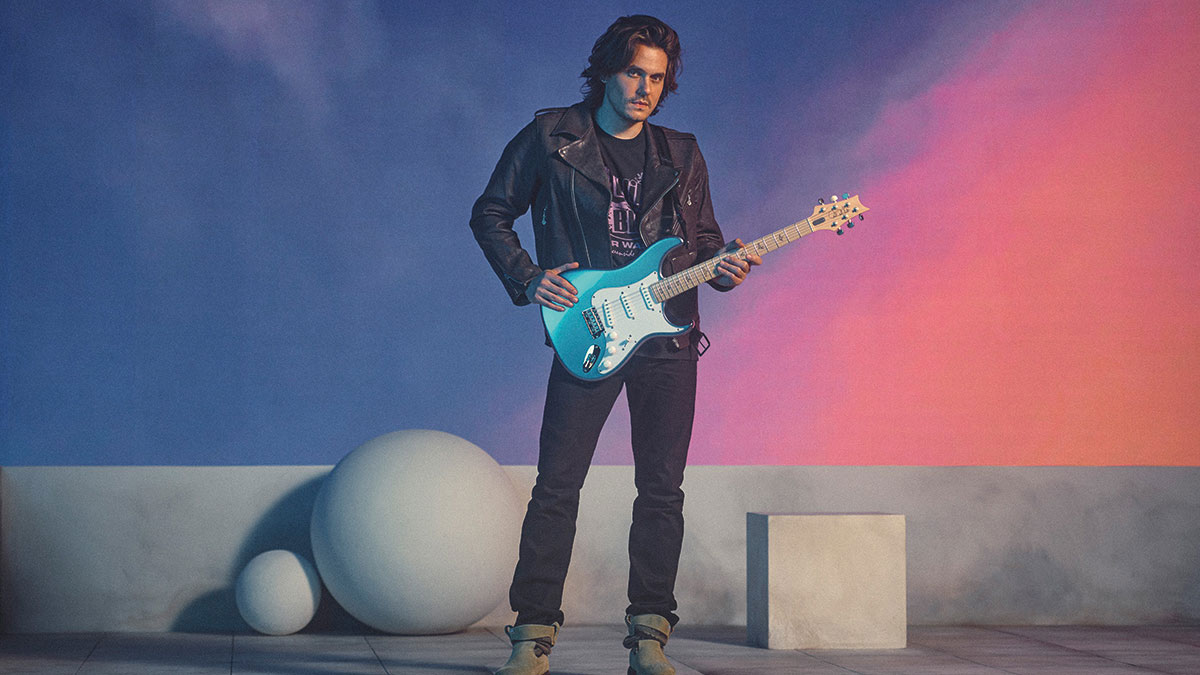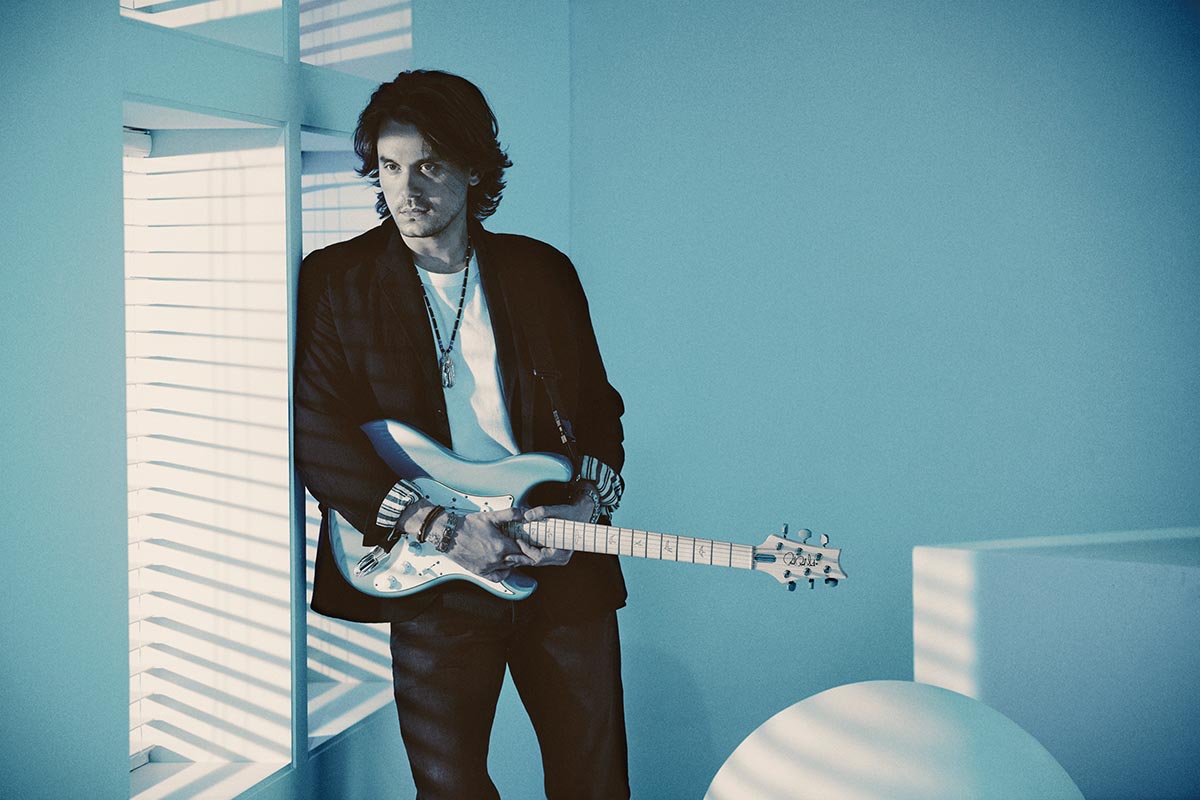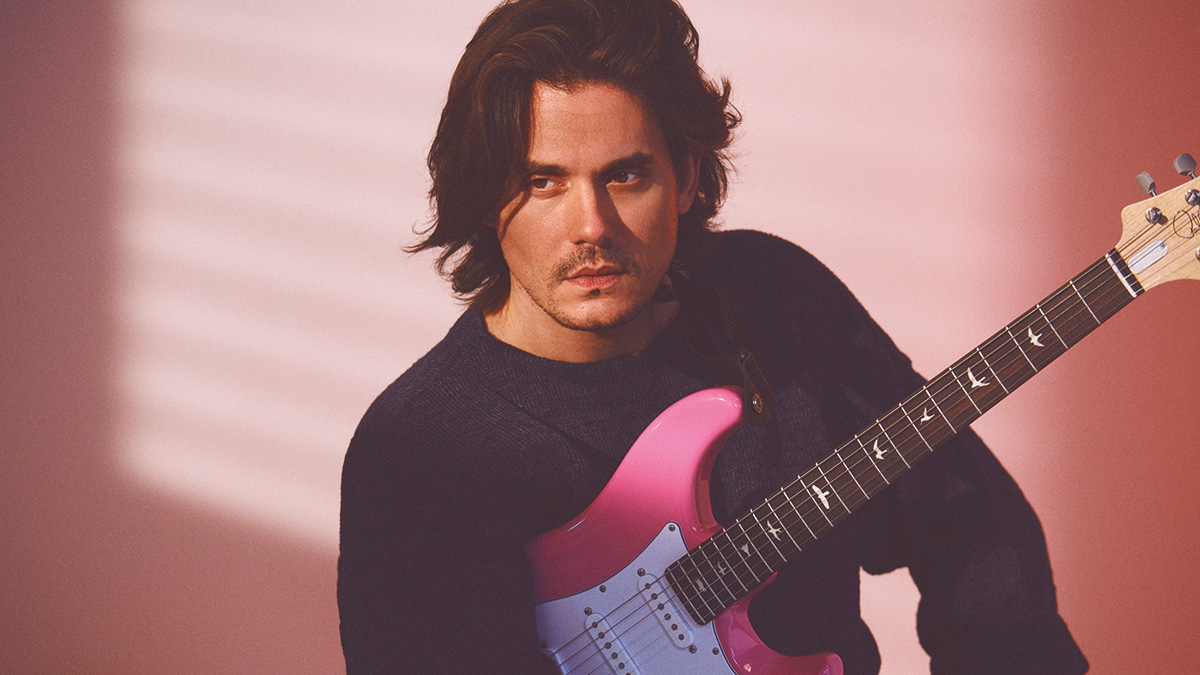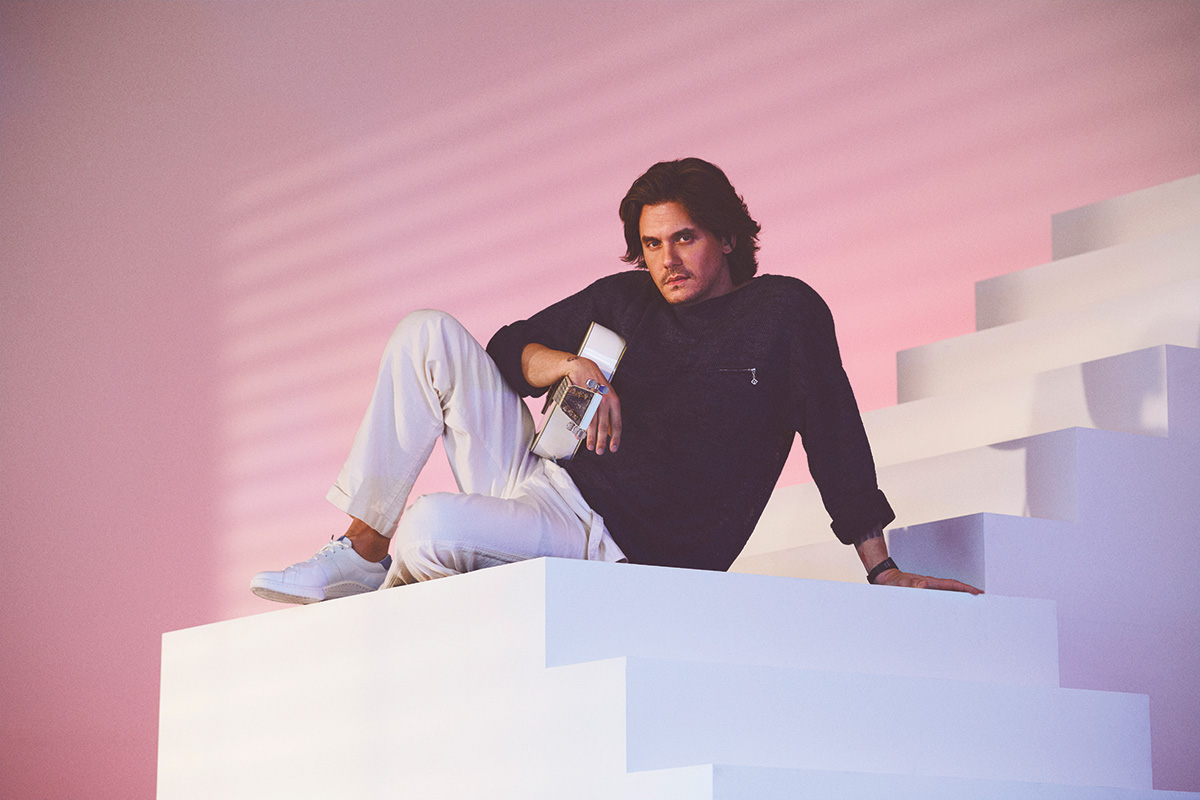John Mayer: “We’re all in the same boat. We’re all sitting down with an electric guitar alone in a room, hoping to trip over something that we’ll never forget”
In this exclusive interview, the blues-rock superstar unpacks the '80s influences behind new album, Sob Rock, and celebrates chorus pedals, pink guitars and Journeyman-era Clapton

Face it: 2020 was a helluva year. We all dealt with the global pandemic, the resulting lockdown and the general disruption and destruction of normal, everyday life in our own way. In John Mayer’s case, he made a record.
And the record he made, Sob Rock, his eighth solo effort overall, is unlike any he has recorded previously. Its 10 tracks look to the past – specifically, the '80s music of Mayer’s childhood – in an effort to conjure a sound that, he admits, brought him comfort in uncomfortable times.
“I started making music that I would find really soothing,” he says. But the record also does something else. In revisiting the sounds of his youth, Sob Rock reconstitutes a sort of pop craftsmanship – tightly arranged, highly melodic, excessively hooky songs executed with session-player proficiency and finished with a big-budget studio sheen – that has been largely jettisoned in an era of bedroom computer recording, flown-in tracks, autotuned vocals, digital cut-and-paste arrangements and earbud-attuned production styles.
Of course, as anyone who has followed Mayer’s career over the past 20 years can attest, this is not the first time he has created music that sounds vaguely '80s. But whereas other artists aiming to invoke the vibe of that decade might merely slather on some sparkly synths, break out a drum machine or rip a hot-rodded solo over a power ballad, Mayer’s musical mind works in more nuanced ways.
Sob Rock succeeds not because it references a sound from the past, but because it does so with such remarkable specificity. It’s an exercise in what the 43-year-old Mayer calls “wish fulfillment.”
“I think everyone who makes music comes at it from a fantasy,” he says, “but for me the fantasy this time was, what if it’s 1988 and I had had a band in the late '60s through the '70s, and now I’m my age in the '80s and people are handing me these things called chorus pedals, or people are going, ‘Hey, you don’t need a tube amp anymore.’ And I go, ‘You don’t? Okay. This sounds great…’ ”
The result is a record that recalls Eric Clapton and Fleetwood Mac, Toto and Peter Gabriel, Bruce Springsteen and Steve Miller and various members of the Eagles – but recalls, precisely, the type of matured, occasionally mellowed-out music these seasoned artists were making in the '80s.
Get The Pick Newsletter
All the latest guitar news, interviews, lessons, reviews, deals and more, direct to your inbox!
I’m using sonic color-coding, like the sonic paint codes from the '80s, but I’m making new images with them
Sounds unusually specific? It is. “I don’t want to say it’s a costume, but it is an intention,” Mayer says. “I’m using sonic color-coding, like the sonic paint codes from the '80s, but I’m making new images with them. I told myself, ‘Don’t steer away from it. If it brings you joy and it brings other people joy, what happens if you just do it?’”
And Mayer did, in fact, do it. From the blooming, chorus-drenched guitar triads that define the ultra-hooky first single, Last Train Home to the laidback rhythms and clean, shimmering licks of Wild Blue, the Springsteen-ian (and we’re talking of Tunnel of Love Bruce here) swell of Carry Me Away to the richly layered instrumentation and adult-contempo vibes of Shot in the Dark, Sob Rock is Mayer at, as he puts it, his most “generous”. The result is an expertly written, beautifully recorded – courtesy of ace producer Don Was – and unabashedly warm and tuneful listen.
“There is nothing in this record that has any sandpaper on it,” Mayer says. “I went, ‘Well, I’m just going to go for it. I’m just going to be as absolutely melodic and generous as I can be.’ And I was just putting more and more and more melody on each and every one of these songs. That’s the fun I had on this record.”
Which is not to say it came easy. “It took forever to work on these songs,” he continues. “It was like, here’s the three-and-a-half minutes – how do you inject it with as many moments and layers as possible? How can you just keep jam-packing it with payoffs? What we’re really talking about is, what’s so wrong about a guilty pleasure? Or, what’s so guilty about someone making a record that goes, ‘I’m setting out to please you as much as I possibly can with the art of melody.’ Someone may not like that, but I’m proud to go down with that ship.”
On the eve of its release, Mayer sat down with Guitar World to discuss how he built, and ultimately steered, the Sob Rock ship, from the music he referenced to the gear he employed to his approach to crafting solos. But before diving into the nuts and bolts of the record, there was one burning question we had to get out of the way…

So let’s just get right to it: In the video for the first single from Sob Rock, Last Train Home, you’re playing your signature PRS Silver Sky model, but in a never-before-seen pink finish. Is that a real thing?
”Well, it’s a real thing in the sense that I have one. As to whether or not it’s a real thing in terms of other people having one? It’s definitely being talked about. [Since this interview was conducted, PRS has officially launched the Roxy Pink finish for the Silver Sky.]
”The fun of having Silver Sky as a project that I can always be working on is that I can test colors out on myself. And in the last couple of years I’ve fallen in love with the L.A. session-guitar concept.
”Like, the old Valley Arts guitars, they’re all sort of these great shades of pink. And I just think there’s something really cool about a pink guitar. So I thought, ‘Well, why don’t I do a pink one for this record?’ Sort of to help tell a little more of a visual story of the music. It’s really fun to just shoot a color on a guitar and go, ‘How does this make me feel?’ I had no idea people would gravitate to it like they have.”
I’m nowhere near the first person to do a pink guitar. But I think it just aligns with this idea of making your own fun
People dig it.
”Actually, the pink guitar in the video is hot pink, and it’s actually too hot. So we went with a cooler pink that I can use going forward. That seems to be the magic slipper, color-wise. I wouldn’t have wanted to begin Silver Sky with a pink guitar, but we’re enough years down the road that we can go a little 'out there' on a couple colors while still keeping the identity of what this guitar is intact.
”And, of course, I’m nowhere near the first person to do a pink guitar. But I think it just aligns with this idea of making your own fun, and of having more fun than we’ve ever had before and taking advantage of the life that’s been handed back to us, hopefully not provisionally.”
The Valley Arts session-musician pink guitar is a pretty specific association, but it’s in line with what you’re doing overall on Sob Rock. The record obviously has a strong '80s sound, but more than that it’s a very particular '80s sound, the kind of sound that artists like Eric Clapton and Fleetwood Mac and Peter Gabriel and Toto – and Steve Lukather, for one, was also a session guy who played Valley Arts guitars – were playing in that decade. The question is, how were you able to home in on that so precisely?
“That’s a good question. And it’s a very flattering observation. I’m very detail-oriented, and I believe the difference between people taking the magic carpet ride with you and not taking the magic carpet ride with you can sometimes come down to what most people would consider an infinitesimally small detail.
“But if we’re talking about tricking your brain or tricking your heart, there are very, very subtle moves to get there. And especially when it comes to the idea of doing something that is certainly borrowing the intentionality of '80s records.
“It’s really easy to apply too much paint to the brush and hit the canvas too hard with the brush stroke and have people go, 'I know what he’s doing, never mind.' I mean, I could have slathered the record in chorus, could have slathered the record in a Jupiter-8 [synthesizer], and that would have certainly let everybody know what my intentions were. 'Oh, he’s made this.'”
You went more granular.
“What I think is really interesting is I’m at the age now where I have the benefit of experience and having lived through that time. Like, I could never fully grasp the '60s because I wasn’t there. And I would probably reduce it in my estimation of what it was. I would go to flower power. Woodstock. VW Beetles.
“But for someone who was alive and a teenager during the '60s, they can tell me so many things that didn’t quite make it through the hoop historically and into a kind of common understanding of that era. So where a lot of people would think that the '80s was all really goofy and neon-colored, well, to me, there was a lot of earnestness.
“The '80s gave us Peter Gabriel. That’s some of the coolest stuff in the world, you know? And what’s interesting is that people now relate to that earnestness again in a real, non-ironic way. So what I set out to do on the record was be really sincere with it.”
The songs, compositionally, had to be strong on their own, no matter how you played them. The songs don’t rely on the sounds, and that’s really important
How did that translate to the music you ultimately created?
“The songs, compositionally, had to be strong on their own, no matter how you played them. The songs don’t rely on the sounds, and that’s really important. Last Train Home works on an acoustic guitar and a vocal as well as it does behind the lens of this idea that, just for one record, I want to go back to what I might’ve sounded like in that era. But it’s still a song of mine.
“I didn’t change anything in the way that I write. So it’s actually a pretty light touch in terms of it feeling like an old record. And it feels like an old record mostly because it’s fully recorded by people together in a room. So all these songs, they’re not fantastically complex.
“But where I had all the fun in the world was in the arrangements. I went deep into the brilliant arrangements of the '80s. And when you start getting into '80s records, the arrangement is as important as the songs and as important as the singer.
Where does the guitar fit into that?
“Everything on this record, you can hear each guitar. And I have been guilty in the past of assigning four guitar parts to do the job of what could have been one better guitar part from scratch. I think we all, as guitar players, have had this experience where we start to kind of duct tape guitar takes together, not linear-wise, but in building a track.
“If one guitar track isn’t right and you keep it, you add another guitar track to beef it up. Then you get diminishing returns and it gets smaller-sounding, so you tack on another one. But what’s really great about the arrangements in the songs from this era is that each instrument is stating its case. It would get in, it was highly audible and it would get out.
“And it was laced with really, really beautiful melodic motifs. Intervallic, dramatic, melodic, strong, loud motifs. So the idea for me with the guitar and the songs was, make it melodic, make it hooky. I want to sing it before it’s over. I want to have it stuck in my head before it’s over.”
There were times where I would take a Jackson and run it through a Rockman, which is as Def Leppard as you can get
When it came to actually laying down the sounds in the studio, did you change up your gear at all to be era-appropriate?
“It’s mostly the same gear. Although we certainly tried. Don Was has said he wishes he could’ve sold tickets to the recording of this album, just for the guitar parts. Because the guitar parts, some of them that never made it to the record, it was just so funny to hear that sound revived.
“There were times where I would take a Jackson and run it through a Rockman, which is as Def Leppard as you can get. It’d be a Jackson through a Rockman with, like, a [Marshall] JMP, and I’d start playing these kinds of Hysteria lines. But then you hear it back and you go, 'I get it, but that’s not me. That was so much fun, but that’s not convincing and that’s not sincere.' So in the end it became this blend of my gear with the intentionality of the music of the past.”

I’m assuming that means, at the base level, the Silver Sky through a variety of tube amps.
“We used different amps all the time, and amps are tricky for me – I think the same amp sounds different on two different days. So we sort of used three amps as one. It’s like, what serves as the woofer, what serves as the crossover and what serves as the tweeter? It’s really fun to build an amp sound that way.
“And interestingly enough, the Dumble really intersects with early '80s session work, right? Like, Stevie Ray Vaughan was kind of an anomaly in that Dumble world because almost everyone else using a Dumble was kind of doing really clean stuff. I mean, I know guys like Larry Carlton and Robben Ford were making it sing with distortion, but it was mostly clean tones you were hearing with that amp.
Last Train Home definitely trades on some very specific musical references. But the rest of the record, the influences are chopped up so fine that it’s almost a powder
“And so it worked really, really well to take a Silver Sky, which is already kind of hi-fi, and run it through a Dumble and a direct, and then maybe an old Fender combo for the softness. Because those old Fenders apologize really well for the notes. But for that kind of session-player, speed-of-note thing, that picking response really comes from direct input or a Dumble amp, which, really, is a direct-input amplifier.
“Even though it’s coming through a speaker, everything in those amps moves so fast, and in the best, cleanest way, that when you pick that single-note stuff, you’re just in heaven because the notes are so crisp.
“And then we actually used a Fractal in some places, too. Because as much as I was thinking, 'What would I have done then?' I was also asking, “What would they have done now?” And if somebody had walked a Fractal into the Thriller sessions? You would have heard a Fractal all over that record.”
Absolutely.
“There’s just no doubt about it. And so that was the fun of it – bending and blending time and eras and influences. The exception was Last Train Home, which, I’m not going to play stupid, Last Train Home definitely trades on some very specific musical references. But the rest of the record, the influences are chopped up so fine that it’s almost a powder.
“You can sort of get one thing or another thing. I mean, I’ve heard people say one band name and another person say another band name off the same song. It’s almost like they’re hearing what it reminds them of more than what it is. I’d love to hear what you think about it…”

I’ll try one. To me, the song Wild Blue sounds like it came straight off Fleetwood Mac’s Tango in the Night – the driving-but-relaxed rhythm, the taut, clean-toned guitar lines, the soft background vocals. If I were to get even more specific, your first solo in that one sounds to my ears like Lindsey Buckingham playing through Mark Knopfler’s gear.
”[Laughs] The solo is certainly a Knopfler thing. Although the song makes me think more of Boz Skaggs in, like ’79, ’80, like a really tightly engineered, two-inch tape thing. Maybe Alan Parsons. Or [Steve Miller Band’s] Abracadabra. But the solo, that’s actually the take from the first time we really played the song. And it’s the only song that I brought in while we were making Sob Rock.
”I had nine songs and this was the 10th, and it came out in the middle of a session for something else. And that’s the take. I didn’t have a guitar pick so I decided to just fingerpick it. And I think it’s through the Fractal, actually. It’s like the 'Studio Clean' setting or something like that. Don’t hold me to that. But it was one of those kinds of settings. Because I was doing a scratch and it was, 'Hey, let’s just play the thing…''”
You mentioned that Last Train Home is the one song where the influences are more overt. What are we hearing on that one?
”That’s a good question. And I have a deep dislike of dishonesty when it comes to creating, so I’ll tell you: I always wished that I could have a song that was on Eric Clapton’s Journeyman album. I loved him so much that I’m not afraid to go, 'I just want to feel what that’s like…'
”Like, the experience of plugging a Strat with noiseless pickups into a Soldano with a chorus pedal. And to hear that back on your own song is funny, poignant, touching, exciting, titillating. I mean, it feels a little bit wrong. But the reason I’m okay telling you this is because Eric has always been someone who turned his test around and showed you his notes.
”Every single time: 'I got this from that person, I got this from him. I got this from her.' So I’m at an age where I’m looking back and I’m really joyously reminiscing about times in my life as a listener, and as a music lover. And I’m going, 'Well, why can’t I just ignite that spark on this one song? And if somebody gets a kick out of it, whether they know why or not, wouldn’t that be great?'”
When I was in high school, it was Pretending. It was Bad Love. It was Running on Faith. If you liked guitar and you liked Eric Clapton, that’s what he was playing
At Guitar World, we talk to a lot of players that cop to wanting to sound like Eric Clapton. But this may be the first time someone has said they wanted to sound like Eric Clapton playing Pretending.
“Oh, well, this is a great conversation. This speaks to what matters to you based on your age, right? This is the whole genesis of Van Halen discussions. It all has to do with how old you were when it hit you. And when I was in high school, it was Pretending. It was Bad Love. It was Running on Faith. If you liked guitar and you liked Eric Clapton, that’s what he was playing if you went to go see him at the New Haven Coliseum.
“I remember seeing kids in school on a Monday showing off their Eric Clapton T-shirts – that was a cool thing. You can’t expect someone who’s 16 years old in 1990 to understand Cream. Not yet. So what finds you if you first pick up a guitar at that time? It’s that record. That record has such a deep place in my heart.”

You play a fair amount of lead guitar on Sob Rock, but similar to Clapton in the '80s, you keep your solos brief – four bars, eight bars, maybe 12 or 16 if you’re feeling generous. Which is also in line with how we would hear session guitarists on a record back then. You knew these people could wail for days, but they stayed within very strict parameters in order to serve the song. For most of your career that’s been your approach as well.
“You know, my ears and my hands are two very, very separate entities, and I let my ears rule. So while it’s fun – just primally fun – to get more time to play a solo, I become deeply upset with myself when I start to hear myself thin out. It’s almost like a fountain pen, and I can always tell when the writing gets thin as a guitar player.
The ear is the producer of the record, and the ear is the one that has to call bullshit on every other part of you as a composer and a musician and a guitar player
“And I don’t tolerate it in myself, even though the other side of myself just wants to let loose. So I’ll let loose… and then I’ll listen back. And the ear is the boss. And my ear goes, 'I will simply not tolerate a solo that’s twice as long as it needs to be. I heard you lose your motifs. I heard you lose your lyricality. I heard you lose your phrasing.'
“That’s why I don’t really consider myself a blues guitar player – because my phrasing gives out after a certain period of time. And I love playing blues guitar. I mean, it’s like constant downhill skiing. It’s an endless water slide. But the ear rules. The ear is the producer of the record, and the ear is the one that has to call bullshit on every other part of you as a composer and a musician and a guitar player.”
Recently you posted a video clip of you playing along to Last Train Home, but with the lead guitar removed from the mix. And you invited people to solo over the track with you, and add their own melodies and lines. I thought that was a really neat thing to do.
“If I can offer a little support to people who love playing guitar and don’t quite have the opportunity to play as much as they want or in all the situations they want, then I’ll do that. Because when we were coming up, we didn’t have anything without a lead guitar, right?
“I had to play over B.B. King. I had to play on top of Stevie Ray Vaughan. The nerviest move you could ever make! And so if I can say to the mix engineer, 'Hey, will you give me one without the lead guitar?,' I’ll do it. And I’m going to do it for as many songs as I can. 'Hey, jump on in, play along with this.' It’s not anything that’s precious to me.
“Look, do you know how flipped out I would have been if I walked through a CD store in 1991 and there was an Eric Clapton import CD from Australia or something that said, 'Journeyman – Lead Guitar Out Version'? I would’ve never gone back to school! I would’ve never left the house. I think about that sometimes. And so that’s why I’m always going to keep doing it if I can. And I can. So I will.”
It’s a way of sort of bringing guitar playing down from the mountaintop, so to speak. And it’s not the only time you’ve done it. Over the past few months on TikTok you’ve posted videos demonstrating how to play songs like Neon and Slow Dancing in a Burning Room, or that allow fans to trade off solos with you. It’s like you’re saying, “You can do this, too.”
“You know, I’ve never seen more people get more out of playing electric guitar than I have this past year. It is such a community. And it brings me back to my roots as a guitar player, as a guitar player alone in my house. So it’s a way of saying that we’re all in the same boat. We’re all sitting down with an electric guitar alone in a room, hoping that maybe this time we’re going to find something or trip over something that we’ll never forget.”
The idea of me playing electric guitar and showing people a little bit of what it breaks down to is my way of kind of saying, 'I’m not that different'
Like Clapton, you’re turning your test around and showing people your notes.
“I don’t need that aspect of untouchability. I’ve never needed that. So I’m okay with going, 'Hey, my floor is a mess too. It’s cables and pedals, and picks are everywhere, and guitars are leaning up against the couch, just like you. And here’s what I personally have been doing on the couch as I’m getting ready to play this thing.'
“You know, I have a guitar just like you have a guitar. And I have dreams just like you have dreams. And if you’re interested in what made my dreams my dreams, well, here’s how I did it. I don’t see it as giving anything away that is proprietary.
“And so the idea of me playing electric guitar and showing people a little bit of what it breaks down to is my way of kind of saying, 'I’m not that different.' I still want to make a song that sounds like Eric Clapton, you know? I still want to wear a big black trench coat. I’m not gonna, but I still wanna. I won’t let myself. But man, wouldn’t that be fun?”
- Sob Rock is out now via Columbia.
Rich is the co-author of the best-selling Nöthin' But a Good Time: The Uncensored History of the '80s Hard Rock Explosion. He is also a recording and performing musician, and a former editor of Guitar World magazine and executive editor of Guitar Aficionado magazine. He has authored several additional books, among them Kurt Cobain: Montage of Heck, the companion to the documentary of the same name.
“His songs are timeless, you can’t tell if they were written in the 1400s or now”: Michael Hurley, guitarist and singer/songwriter known as the ‘Godfather of freak folk,’ dies at 83
“The future is pretty bright”: Norman's Rare Guitars has unearthed another future blues great – and the 15-year-old guitar star has already jammed with Michael Lemmo











